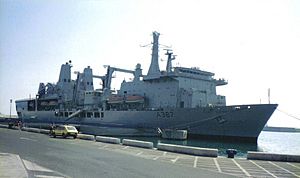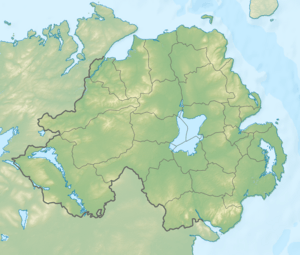RFA Fort Victoria bombing facts for kids
Quick facts for kids RFA Fort Victoria bombing |
|
|---|---|
| Part of The Troubles | |

RFA Fort Victoria
|
|
| Location | Harland and Wolff shipyard, Port of Belfast |
| Coordinates | 54°37′07.38″N 5°53′42.24″W / 54.6187167°N 5.8950667°W |
| Date | 6 September 1990 |
| Target | RFA Fort Victoria (A387) |
| Weapons | 2 explosive charges |
| Deaths | None |
|
Non-fatal injuries
|
None |
| Perpetrator | Provisional Irish Republican Army |
On September 6, 1990, a group called the Provisional Irish Republican Army (IRA) placed two bombs on a ship named RFA Fort Victoria. This happened at the Harland and Wolff shipyard in Belfast, Northern Ireland. The ship had just been built there. One bomb exploded in the engine room, causing a lot of damage and flooding. The second bomb did not explode and was safely removed later. Because of this attack, the Fort Victoria could not be used for two more years.
The Attack on RFA Fort Victoria
The RFA Fort Victoria is a very large supply ship. It weighs over 31,000 tons. The ship was ordered in 1986 and launched in May 1990. Its name was officially given by the Duchess of York in June.
Just a few months after being named, on September 6, 1990, the IRA placed two bombs on board. The ship was still at the dock. After the IRA gave a warning call, one of the bombs exploded. This caused a lot of damage inside the engine room. The room filled with water, and the ship tilted sharply. It looked like the ship might sink.
Emergency teams worked for many hours. They pumped the water out of the engine room. Their hard work saved the ship from sinking. The head of Harland and Wolff, John Parker, praised the engineers for their bravery.
It was not known that a second bomb was on the ship until 24 hours later. The IRA made another phone call to tell them. It took two weeks to find and safely remove this second bomb. This caused even more delays in getting the ship ready.
What Happened After
The Fort Victoria finally left Belfast for testing on June 29, 1992. This was two years later than planned. Some people thought the attack was meant to hurt the shipyard workers. However, an Irish newspaper said this was not true. They said the attack was on a valuable British military ship.
The newspaper also stated that the ship cost £130 million. They said the attack showed the IRA could still challenge British forces. The IRA said they would not accept military equipment being built in Northern Ireland. A politician named Peter Robinson suggested that shipyard workers should be checked more carefully.
Because of the attack and other building problems, the ship was not ready until 1993. This was three years later than first planned. The final cost of the ship was £190 million. This was £63 million more than what was first expected in 1986.


